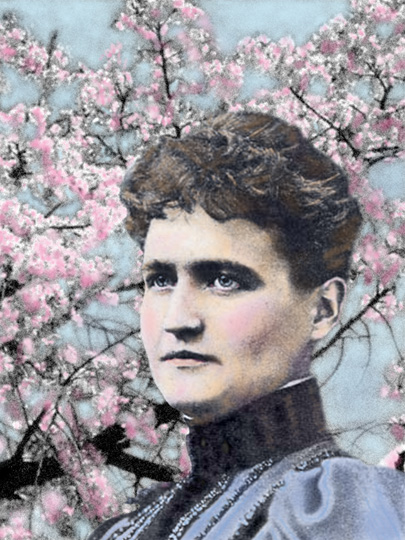Eliza Ruhama Scidmore (1856-1928)
Every age has strong, independent women who are driven to follow their hearts and minds whatever the cost. One such maverick was Eliza Ruhamah Scidmore (1856-1928). Today she is known best — if at all — for initiating the idea of planting Japanese cherry trees in Washington, D.C.
Yet she was so much more.
Overlooked for a century, Scidmore has been attracting greater attention in recent years, thanks in part to the centennial of Washington’s first cherry trees in 2012.A Path-Breaking Woman
Born just before before the Civil War, Eliza Ruhamah Scidmore (1856-1928) rose from modest beginnings to become one of the most accomplished women of her day. When few woman of her day pursued careers, newspaper society pages routinely reported the comings and goings of “Miss Scidmore.”
Her achievements at that time boggle the mind:
- prolific writer, who published six books and wrote for many publications
- intrepid traveler, whose adventures took her to Alaska, Japan, Java, China India, and other places little known to most Americans
- first female board member of the National Geographic Society, and a contributing writer and photographer for its now-famous magazine (the Smithsonian Institution also has a collection of her photographs)
- collector of Oriental art, many pieces of which she loaned to U.S. museums
- international peace advocate late in life
Wide-Ranging Travels
In the summer of 1883, while still in her 20s, Scidmore took a sightseeing trip to Alaska, traveling aboard a mail steamer named the Idaho. That voyage became historic.
A couple of years later, Scidmore went to Japan for the first time. Thus began her long fascination with the country and its culture. Her book Jinrikisha Days in Japan (1891) is now a classic of travel literature.
Eliza’s brother George spent most of his U.S. consular career in Japan, giving her a base for travels across the Far East.
Their mother also spent long periods in Japan living with her son. Today, all three Scidmores are interred at a cemetery in Yokohama.
Cherry Trees on the Potomac
Her love of cherry blossoms led Scidmore to suggest to park officials in Washington that they add some cherry trees to landscaping plans for the new Potomac Park taking shape on formerly marshy ground near the Washington Monument.
The men showed no interest, but Scidmore kept the idea alive in her mind for more than two decades.
She finally saw her dream become a reality on March 27, 1912, when she witnessed the historic event at which First Lady Helen Taft planted the first Japanese cherry tree beside the Tidal Basin in Washington.
Article by Diana Parsell
Books by Eliza Scidmore published by Trotamundas Press:
"Winter India"

No hay comentarios:
Publicar un comentario